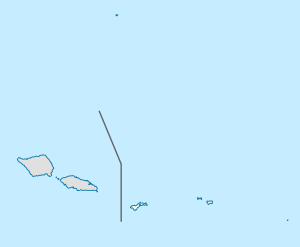Aʻoloau, American Samoa
A'oloau | |
|---|---|
Village | |
 Panorama from A'oloau, facing south | |
| Coordinates: 14°19′11″S 170°46′12″W / 14.31972°S 170.77000°W | |
| Country | |
| Territory | |
| Area | |
| • Total | 2.5 sq mi (6.5 km2) |
| Population (2012) | |
| • Total | 790 |
| • Density | 310/sq mi (120/km2) |
Aoloau Village on top of the mountain
 | |
Aoloau is a village in the west of Tutuila Island, American Samoa. It is located inland, 5 miles (8 km) southwest of Pago Pago. It is also known as A’oloaufou, which means "new A’olou". An abandoned area in town is known as A'olautuai, which means Old A’oloau’. Aoloau nickname is Nuu Puaolele which it mean the Fog Viilage.[1] The village is reached from a road near Shins Mart in the village of Pava'ia'i. It sits inland, high on the central plain of Tutuila.[2] It has an elevation of 1,340 ft (410 m).[3] A hiking trail from A’oloaufou leads down to A'asu on Massacre Bay.[4]
Massacre Bay Trail
A’oloaufou is home to a hiking trail which leads to the village of Aasu. Aasu is a historic village where, on December 11, 1787, twelve men from the La Pérouse’ ships La Boussole and Astrolabe and 39 Samoans were killed in a battle. Aasu is a near-abandoned village which is home to just a few families. Aasu village has no road outlet, and can only be reached by hiking trails.[5]
The trail from A’oloaufou takes off downhill just east of a colorful garden which was created by Department of Tourism. It is a 2.5-mile trail which leads to the beach and monument in Aasu. The trail down is mostly made of volcanic clay which may be muddy, waxy and treacherous when wet. It is possible to camp at Aasu village before returning to A’oloaufou. Other trails in A’oloaufou includes a trail to the abandoned village of A’oloautuai, as well as another trail leading down the ridge to the village of Fagamalo.[6]
References
- ^ Talbot, Dorinda and Deanna Swaney (1998). Samoa. Lonely Planet. Page 173. ISBN 9780864425553.
- ^ Goodwin,Bill (2006). Frommer’s South Pacific. Wiley. Page 402. ISBN 9780471769804.
- ^ https://www.nps.gov/npsa/planyourvisit/upload/Area_Map.pdf
- ^ https://www.lonelyplanet.com/american-samoa/tutuila/activities/massacre-bay/a/poi-act/1456121/362248
- ^ Swaney, Deanna (1994). Samoa: Western & American Samoa: a Lonely Planet Travel Survival Kit. Lonely Planet Publications. Pages 181-182. ISBN 9780864422255.
- ^ Swaney, Deanna (1994). Samoa: Western & American Samoa: a Lonely Planet Travel Survival Kit. Lonely Planet Publications. Pages 181-182. ISBN 9780864422255.

